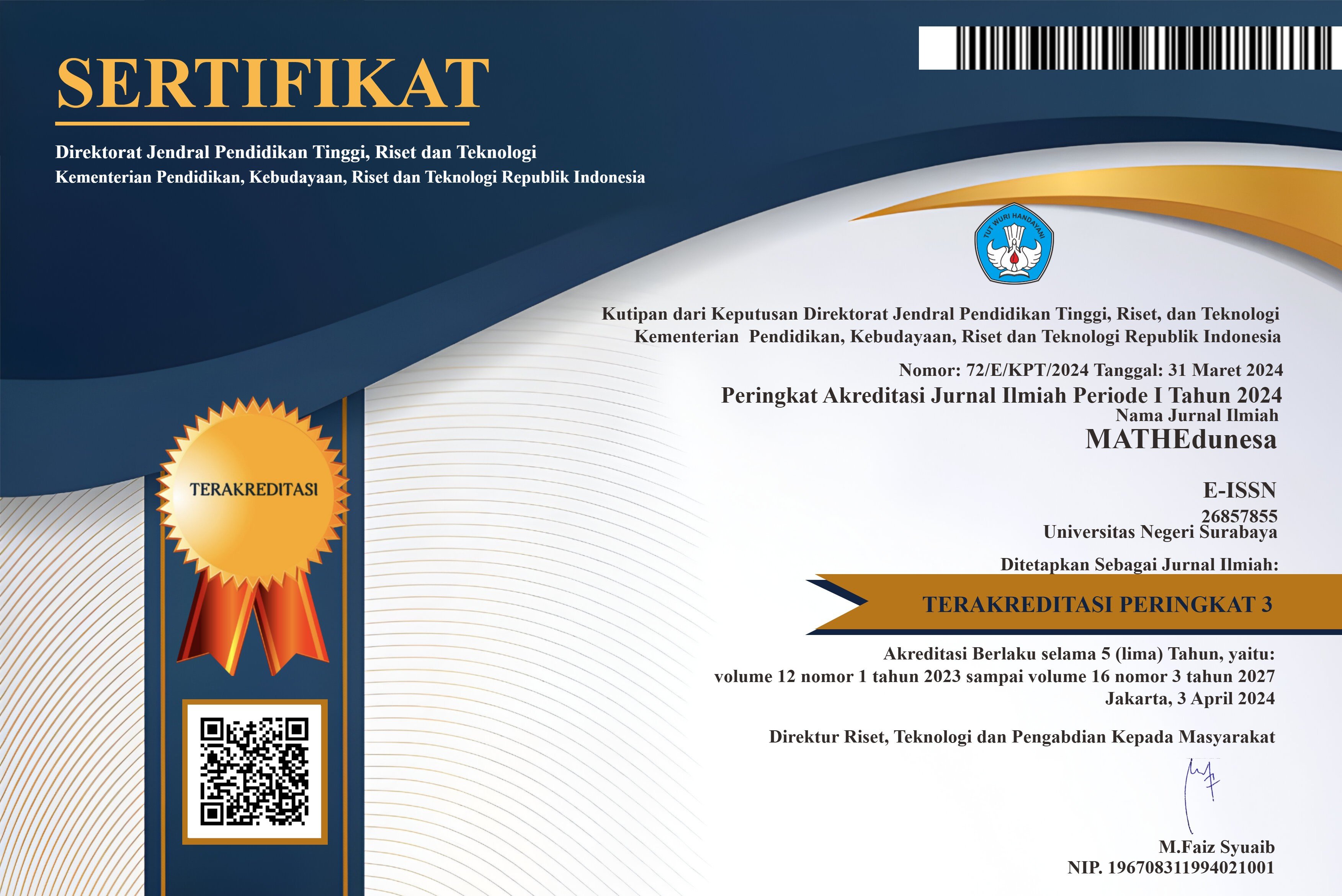PROSES BERPIKIR KREATIF SISWA SMA DALAM MEMECAHKAN MASALAH MATEMATIKA OPENENDED DITINJAU DARI KEMAMPUAN MATEMATIKA
DOI:
https://doi.org/10.26740/mathedunesa.v6n2.p%25pAbstract
Abstrak
Tantangan masa depan dengan persaingan yang semakin ketat memerlukan kompetensi lulusan yang tidak
hanya terampil namun juga kreatif. Proses berpikir kreatif merupakan proses berpikir seseorang dalam
menemukan ide baru dengan cara sintesis ide, membangun ide, merencanakan penerapan ide, dan menerapkan
ide. Untuk mengetahui proses berpikir kreatif siswa, guru dapat memberikan masalah matematika yang openended. Siswa memecahkan masalah tersebut dengan ide yang berbeda-beda berdasarkan kemampuan yang
dimilikinya. Apabila proses berpikir kreatif siswa dengan tingkat kemampuan matematika berbeda dapat
dideskripsikan diharapkan bisa bermanfaat untuk mengoptimalkan pembelajaran matematika. Tujuan dari
penelitian ini untuk mendeskripsikan proses berpikir kreatif siswa SMA dalam memecahkan masalah matematika
open-ended ditinjau dari kemampuan matematika. Penelitian ini merupakan penelitian deskriptif kualitatif di
kelas XI SMA Negeri 1 Sidoarjo. Berdasarkan hasil tes kemampuan matematika, siswa dikelompokkan dalam
tiga kategori yaitu tinggi, sedang dan rendah. Kemudian, setiap kategori dipilih satu siswa sebagai subjek dalam
penelitian ini. Metode pengumpulan data yang digunakan adalah metode tes dan wawancara.
Hasil penelitian menunjukkan proses berpikir kreatif siswa berkemampuan matematika tinggi dalam
(1)tahap menyintesis ide berdasarkan pengalaman belajar di kelas, dengan melihat gambar, rumus-rumus bangun
datar dan ukurannya; (2)tahap membangun ide, mempertimbangkan kemudahan cara dalam menggunakan rumus
yang sudah diketahui, subjek menggunakan rumus bangun datar yang lain; (3)tahap merencanakan penerapan
ide, dilakukan dengan lancar dan produktif; (4)tahap menerapkan ide, subjek memenuhi semua aspek berpikir
kreatif.
Proses berpikir kreatif siswa berkemampuan matematika sedang dalam (1)tahap menyintesis ide
berdasarkan pengalaman belajar di kelas, dengan melihat gambar dan rumus-rumus bangun datar; (2)tahap
membangun ide mempertimbangkan kesesuaian hasil akhir dari cara berbeda, menggunakan rumus bangun datar
lain; (3)tahap merencanakan penerapan ide, dilakukan dengan dengan lancar dan produktif, menggunakan cara
yang lebih sederhana; (4)tahap menerapkan ide, subjek memenuhi semua aspek berpikir kreatif.
Proses berpikir kreatif siswa berkemampuan matematika rendah dalam (1)menyintesis ide berdasarkan pada
pengalaman belajar di kelas, dengan melihat gambar dan rumus bangun datar; (2)tahap membangun ide
menggunakan rumus bangun datar yang diketahui, mempertimbangkan kemudahan cara dengan memperhatikan
hal-hal yang diketahui dari masalah tersebut; (3)tahap merencanakan penerapan ide, dilakukan dengan tidak
produktif; (4)tahap menerapkan ide, subjek tidak memenuhi aspek berpikir kreatif.
Kata kunci: Proses Berpikir Kreatif, Masalah Matematika Open-ended, Kemampuan Matematika.
Abstract
The challenges of the future with increasingly fierce competition requires competence of graduates who are
not only skilled but also creative. The process of creative thinking is the thought process of someone to find a
new idea by synthesizing the idea, building the idea, planning the application of the idea, and applying it. To
know the process of creative thinking of students, teachers can give open-ended mathematic problem. Students
solve the problem with their ideas based on their abilities. If the process of creative thinking of students with
different levels of math skills can be described, is expected to be useful for optimizing the learning of
mathematics. The purpose of this research is to describe the process of creative thinking of senior high school
students in open-ended mathematic problem solving based on mathematic ability of student. This research is a
qualitative descriptive research in 11th grade of SMA Negeri 1 Sidoarjo. Based on the results of math skill test,
students are grouped into three categories, they are high, intermediate, and low capability students. Next, from
each category is selected one student as a subject for this research. Data collection methods that are used are the
method of tests and interviews.
The result showed that the creative thinking processes of student who have high mathematic ability in (1)
the stage of synthesizing idea, she depending on the formula that had been taught, by saw the picture, the
formulas of the planes and its measures; (2) in the stage of building the idea, she was considering the easiest way
in using the formula that was known, she also was using the formula of the other plane; (3)in the stage of
planning the implementation of the idea, she was answering fluently and productively; (4) in the stage of
applying ideas, she was fulfilling all aspects of creative thinking.
"> The creative thinking processes of student who have intermediate mathematic ability in (1) the stage of
synthesizing ideas based on his learning experience in the classroom, by saw the picture and the formulas of the
planes; (2) in the stage of building the idea, he was considering in common end result by using in various ways;
(3) in the stage of planning the implementation of the idea, he was answering fluently and productively, he was
using a more simple way; (4) in the stage of applying ideas, he was fulfilling all aspects of creative thinking.
The creative thinking processes of student who have low mathematic ability in (1) the stage of synthesizing
ideas based on her learning experience in the classroom, by saw the picture and the formula of the plane; (2) the
stage of building the idea, she was using the formula of plane that is known, and she was considering a more
simple way by paying attention something that was given in the problem; (3) the stage of planning the
implementation of the idea, she was answering unproductively; (4) in stages of applying the idea, she wasn’t
fulfilling all aspects of creative thinking.
Keywords: Creative Thinking Processes, Open-ended Mathematical Problems, Mathematical Ability.
Downloads
Downloads
Published
Issue
Section
 Abstract views: 103
,
Abstract views: 103
, PDF Downloads: 226
PDF Downloads: 226




